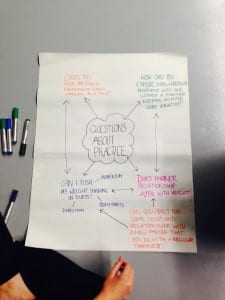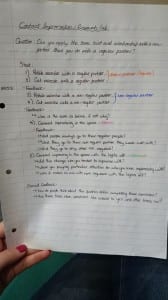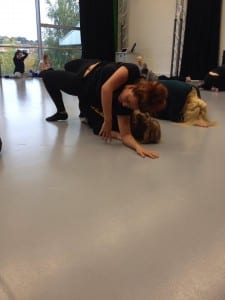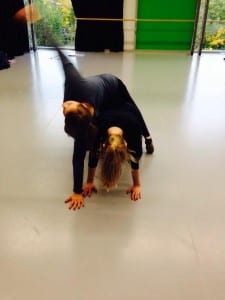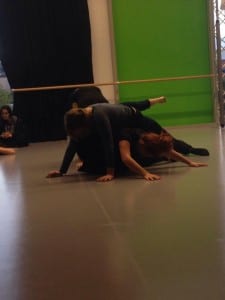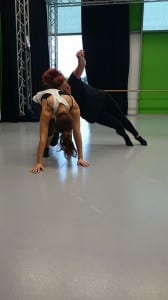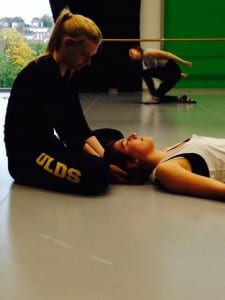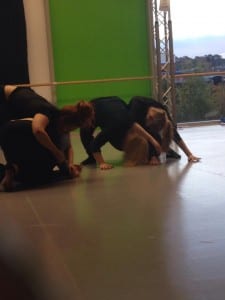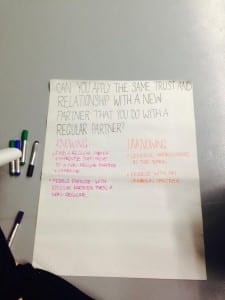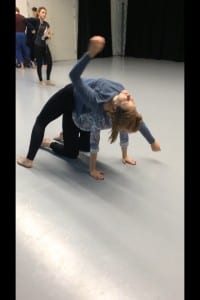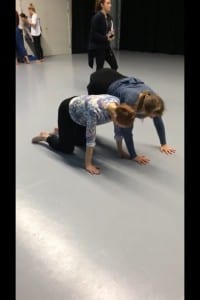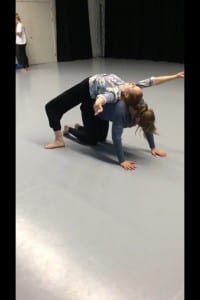Today’s session focused on giving and receiving weight through a series of small tasks that eventually led to performing more advance lifts. To begin with, we got into partners and one partner would slowly move through the space, creating different shapes with their body whilst the other partner would trace the lines of their different body parts while they moved. This task was developed by partner A putting pressure with their hands on partner B’s body parts as they gave resistance to see where the movement could lead to. I initially felt this was effective way of moving because when my partner placed pressure into certain places on my body, I reacted unconsciously by giving resistance as I moved away from the pressure they were giving me, which enabled me to expand my movement options. However, this was further developed by using the whole body, using just not the hands but other body parts to apply pressure. Partner A would apply the pressure while partner B would react to the pressure and move with resistance. I felt that using the body created something more interesting and further expanded my movement options and choices, allowing me to move in a different to before.
The next exercise involved experimenting with the use of continuous giving and taking weight in partners. This involved one partner creating a support in a form on a table top whilst their partner placed themselves on their back, creating a back bend. The partner who is positioned in a back bend, slowly curls one of the feet under their partner, keeping in contact with their partner at all times to flip around and slowly become the supportive table top for their partner. Therefore, the partner’s have alternated roles as the under dancer has become the over dancer, with the partner who was originally the table top is now on the back of their partner in a back bend position. In this exercise, it important to stabilise your centre of gravity in order to move safely around each other. When I was performing as the role on the under dance, I ensured that I created a stable position to enable my partner to move safely over the top of me and safely receive their weight. Also, when I was performing the role of the over dancer I had to be aware of where my centre of gravity was, making sure my pelvis was safely placed on the back of my partner and my balance was evenly distributed. “Centre of gravity is the place in a system or body where the weight is evenly dispersed and all sides are in balance”
Before we developed into more advance lifts, we carried out various tasks to practise the idea of giving and receiving weight. The first exercise involved a counter balance in partners, as one partner would pull their partner by the hand and swing them in a semi – circle motion into the space. The partner would jump into the space and then the roles would switch. This exercise was then developed by one partner being lowered to the floor, still positioned in a counter balance in preparation for them to jump up and be caught in the arms of their partner. It is important to take into account your centre of gravity in this exercise to receive and give weight in a safe manner. This means to make sure the stomachs are in line with each other. In this exercise, I felt more confident to receive my partner’s weight and catching them in mid air than I did jumping and being caught by my partner. I was a bit hesitant to jump at first because I was concious of giving them weight and of falling but with a few more practises, I became more confident in carrying out the exercise. After this, we developed this into a side lean lift. This consisted of partner A having their hand around their partner B’s waist, leaning to the side to pick them up off the ground in mid air. I found this lift more simpler that the others because I was able to provide a strong support for my partner and I wasn’t as reluctant to give my weight to my partner.
We developed all these lifts into much more advance lifts. The first lift consisted of one partner jumping into the arms of the partner in a foetal like position and the partner who was carrying their partner would spin them around in a circle. This was developed by the partner being carried extending their legs out into an almost plank like position whilst once again their partner span them around in a circle. In comparison to the other advance lifts, I found this lift quite enjoyable and easy to perform. However, the over back lift was one of the most difficult. This lift involved partner A positioning their pelvis on the back of partner B while partner B would crouch down to form a strong support and lower their pelvis, making it easier for partner A to position themselves. Partner A would then lean sidewards into partner B and partner B would pick partner A up to lift them over their back and establish and over the back, side lean lift. I found both roles: the lifter and the one being lifted difficult. I believe it was due to not positioning my pelvis correctly in both roles, as this is one aspect I found particularly challenging. I discovered that I am a bit wary of giving other people my weight but after a few more attempts I was able to be lifted. However, I found it difficult to lift other people in this lift but I want to develop and practise this and position myself in a safe way to lift other people up.
Towards the end of the lesson we carried out a short duet improvisation task, experimenting with the notions of giving and receiving weight. I have discovered a lot more movement ability available to me by incorporating different types of lifts. I did find it difficult to initiate lifts without the use of verbal communication because they are more advanced than I am used to. However, this is something I need to overcome and listen to other people’s body in order to experiment. On the other hand, I feel like I pushed myself in this task and balanced myself as the under and over dance, initiating movement as well as giving my partner my weight.
In this weeks jam, the focus was on solos, duets and trios. Due to it being a smaller group, I found myself working with everyone and alternating between the role of the under and over dancer, especially with people I don’t normally work with. Furthermore, I noticed that I was more confident on giving people my weight. For example, there was one instance where I was performing in a trio and I had my weight over two other people and I lifted my arms and legs off so it was upper body balancing on them. This is something I wouldn’t have usually done at the beginning of the semester but I feel that I am more confident in giving my weight to people in safe manner. However, I still would like to push myself further and experiment further with lifts, as well as performing them at a higher level as I tend to stay wuite grounded.
Bibliography
Woodhull, A. (1997) Centre of Gravity. Contact Quarterly/Contact Improvisation Sourcebook 1(4)43-4.
